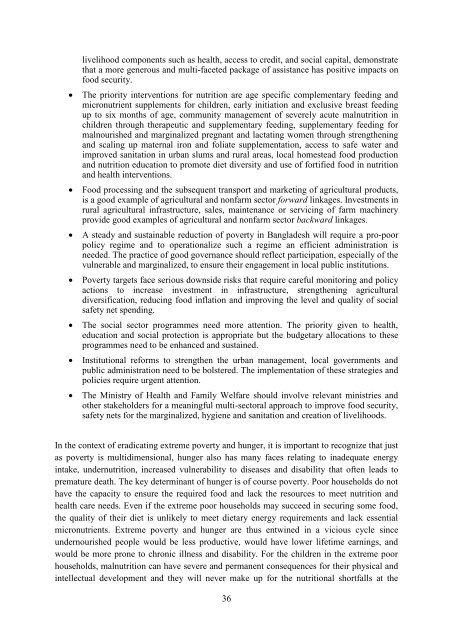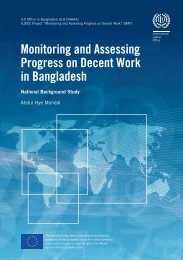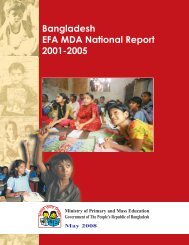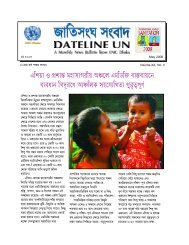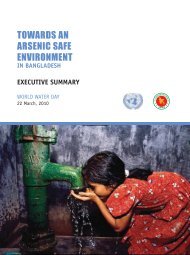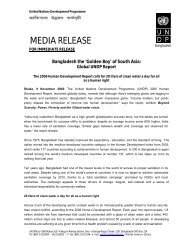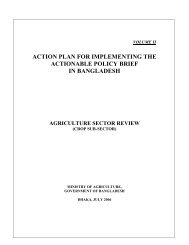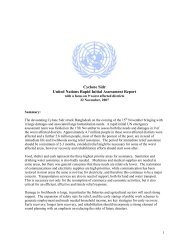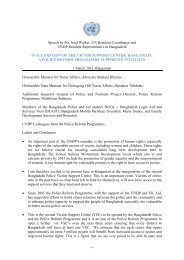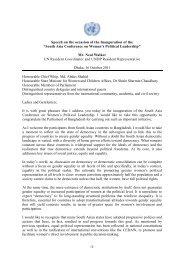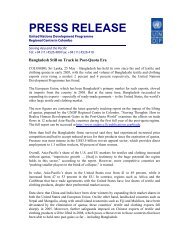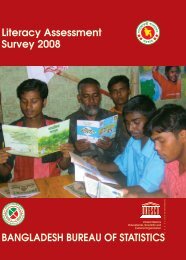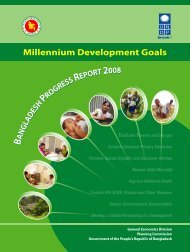MDG Report 2012 - United Nations in Bangladesh
MDG Report 2012 - United Nations in Bangladesh
MDG Report 2012 - United Nations in Bangladesh
- No tags were found...
You also want an ePaper? Increase the reach of your titles
YUMPU automatically turns print PDFs into web optimized ePapers that Google loves.
livelihood components such as health, access to credit, and social capital, demonstratethat a more generous and multi-faceted package of assistance has positive impacts onfood security.The priority <strong>in</strong>terventions for nutrition are age specific complementary feed<strong>in</strong>g andmicronutrient supplements for children, early <strong>in</strong>itiation and exclusive breast feed<strong>in</strong>gup to six months of age, community management of severely acute malnutrition <strong>in</strong>children through therapeutic and supplementary feed<strong>in</strong>g, supplementary feed<strong>in</strong>g formalnourished and marg<strong>in</strong>alized pregnant and lactat<strong>in</strong>g women through strengthen<strong>in</strong>gand scal<strong>in</strong>g up maternal iron and foliate supplementation, access to safe water andimproved sanitation <strong>in</strong> urban slums and rural areas, local homestead food productionand nutrition education to promote diet diversity and use of fortified food <strong>in</strong> nutritionand health <strong>in</strong>terventions.Food process<strong>in</strong>g and the subsequent transport and market<strong>in</strong>g of agricultural products,is a good example of agricultural and nonfarm sector forward l<strong>in</strong>kages. Investments <strong>in</strong>rural agricultural <strong>in</strong>frastructure, sales, ma<strong>in</strong>tenance or servic<strong>in</strong>g of farm mach<strong>in</strong>eryprovide good examples of agricultural and nonfarm sector backward l<strong>in</strong>kages.A steady and susta<strong>in</strong>able reduction of poverty <strong>in</strong> <strong>Bangladesh</strong> will require a pro-poorpolicy regime and to operationalize such a regime an efficient adm<strong>in</strong>istration isneeded. The practice of good governance should reflect participation, especially of thevulnerable and marg<strong>in</strong>alized, to ensure their engagement <strong>in</strong> local public <strong>in</strong>stitutions.Poverty targets face serious downside risks that require careful monitor<strong>in</strong>g and policyactions to <strong>in</strong>crease <strong>in</strong>vestment <strong>in</strong> <strong>in</strong>frastructure, strengthen<strong>in</strong>g agriculturaldiversification, reduc<strong>in</strong>g food <strong>in</strong>flation and improv<strong>in</strong>g the level and quality of socialsafety net spend<strong>in</strong>g.The social sector programmes need more attention. The priority given to health,education and social protection is appropriate but the budgetary allocations to theseprogrammes need to be enhanced and susta<strong>in</strong>ed.Institutional reforms to strengthen the urban management, local governments andpublic adm<strong>in</strong>istration need to be bolstered. The implementation of these strategies andpolicies require urgent attention.The M<strong>in</strong>istry of Health and Family Welfare should <strong>in</strong>volve relevant m<strong>in</strong>istries andother stakeholders for a mean<strong>in</strong>gful multi-sectoral approach to improve food security,safety nets for the marg<strong>in</strong>alized, hygiene and sanitation and creation of livelihoods.In the context of eradicat<strong>in</strong>g extreme poverty and hunger, it is important to recognize that justas poverty is multidimensional, hunger also has many faces relat<strong>in</strong>g to <strong>in</strong>adequate energy<strong>in</strong>take, undernutrition, <strong>in</strong>creased vulnerability to diseases and disability that often leads topremature death. The key determ<strong>in</strong>ant of hunger is of course poverty. Poor households do nothave the capacity to ensure the required food and lack the resources to meet nutrition andhealth care needs. Even if the extreme poor households may succeed <strong>in</strong> secur<strong>in</strong>g some food,the quality of their diet is unlikely to meet dietary energy requirements and lack essentialmicronutrients. Extreme poverty and hunger are thus entw<strong>in</strong>ed <strong>in</strong> a vicious cycle s<strong>in</strong>ceundernourished people would be less productive, would have lower lifetime earn<strong>in</strong>gs, andwould be more prone to chronic illness and disability. For the children <strong>in</strong> the extreme poorhouseholds, malnutrition can have severe and permanent consequences for their physical and<strong>in</strong>tellectual development and they will never make up for the nutritional shortfalls at the36


